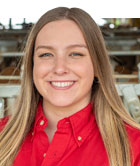
A well-fed cow is a productive cow. By well-fed, I do not mean the cow is overeating; the goal is to provide the best nutrients and highest quality food.
On a recent visit to Rock River Laboratory Inc., Watertown, Wis., I observed the technical process of forage testing. While there, I learned how important sample size and collection is when testing forages.
When discussing this topic with John Goeser, Rock River Laboratory’s animal nutritionist and research and innovation director, he explained that an incorrect sample size can alter the results. Inexact results make it more difficult for farmers to fix their rations or know product values.
Goeser shared that the optimal amount for a sample is 100 to 200 grams or a quart-sized bag. A lab is only able to test so much of the sample and if it is too big, they must divide it into smaller amounts. When doing this, the lab employees do their best to blend the entire sample together, but there is no promise that the outcome will be as well-mixed as if it were to come fresh from a TMR mixer or silo.
When grabbing a sample from an upright silo, Oklahoma State University Extension’s Hailin Zhang, director of the soil, water, and forage analytical laboratory, and Daren Redfearn, forage and pasture management specialist, said to avoid silage two to three feet from the top or bottom. Grabbing from this range could intensify the likelihood of mold, damage, or having a sample that is unrepresentative to the true silage.
Zhang and Redfearn said to take 12 handfuls as the silage is unloaded from the silo. After that, the sample should be divided into quarters and the two opposing quarters should be saved. If silage is not being unloaded at the time, the farmer can retrieve 12 handfuls from the silage that has been thrown down for feeding.
In the instance of a horizontal silo or bunker, the silo must be well-opened prior to sampling. Samples should be taken across the whole surface of the bunker’s face.
If possible, Goeser recommended grabbing the sample while the TMR is being fed. Farmers can use a feed scoop or their own hand to grab the mix.
Zhang and Redfearn advised fresh cut silage samples to be placed in the freezer before being shipped to prevent molding. Additionally, to avoid weekend delays, producers should mail samples early in the week.
As always, farmers need to use safety precautions when going about the sample collection process. It is vital that farmers approach a TMR wagon or silo in the safest manner.

Jessica Schmitt grew up working on her family’s dairy farm near Fort Atkinson, Iowa. She recently completed her junior year at Iowa State University where she is triple majoring in dairy science, international agriculture, and agricultural and life sciences education with a communications option. Schmitt is serving as the 2021 Hoard’s Dairyman editorial intern this summer.